When it comes to elegant brunch options, lemon lavender scones are top of the list. Whether it’s for spring get-togethers, bridal or baby showers, Mother’s Day, or tea time with friends, this recipe checks all the boxes.
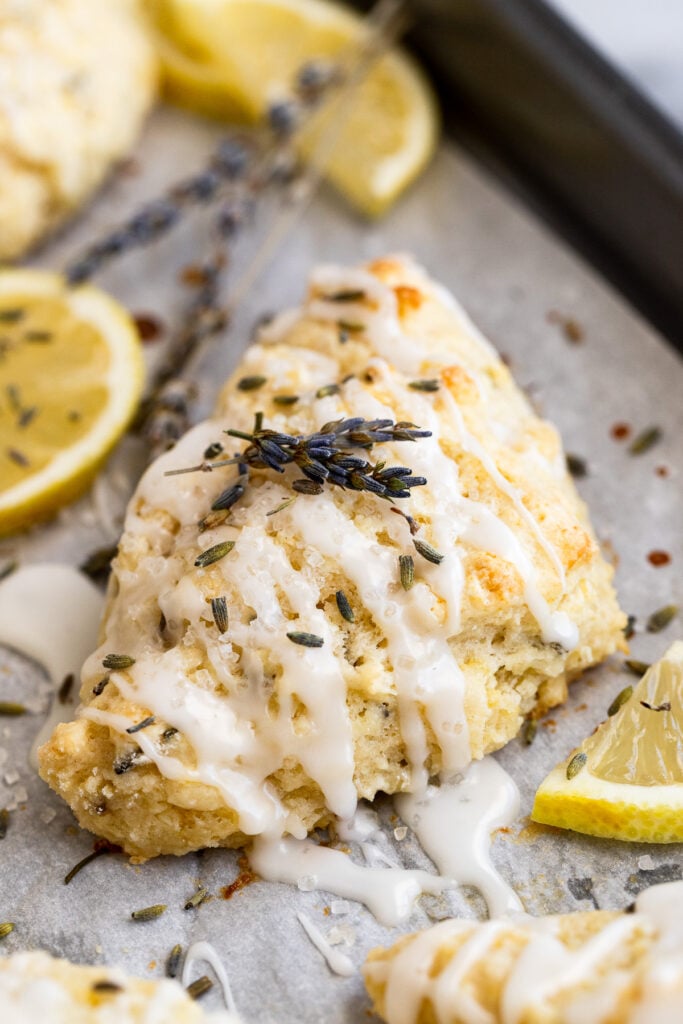
The flavor combination of lemon and lavender is divine. Let’s get the first question out of the way: “do they taste like hand soap…or lotion?”. Asked because maybe you’ve had the experience of biting into a lavender baked good and its…too floral. Or maybe just the thought makes you nervous.
I reassure you, there is no soapiness around here! Dried lavender infuses an aromatic flavor throughout the scones that is subtle and inviting, and while yes floral, but in the best way possible. Paired with bright, citrusy lemon, they balance each other out. A match made in heaven.
The scones themselves are soft and moist (no dry scones here!). Drizzled with powdered sugar icing for a sweet finish, they’re just what your breakfast table needs!
Where to buy Culinary Lavender
The first thing is to make sure you have dried food-grade lavender to bake with! You have a few options:
- I use this dried culinary lavender from Amazon. It’s high-quality, organic lavender straight from the fields of France (not sponsored, but it is an affiliate link). Do be warned, because it’s au natural, you may need to pick out an extra branch here or there before mixing it into your scones.
- Check Whole Foods or a natural foods store. I’ve seen it in the bulk food section, but they may also sell packages.
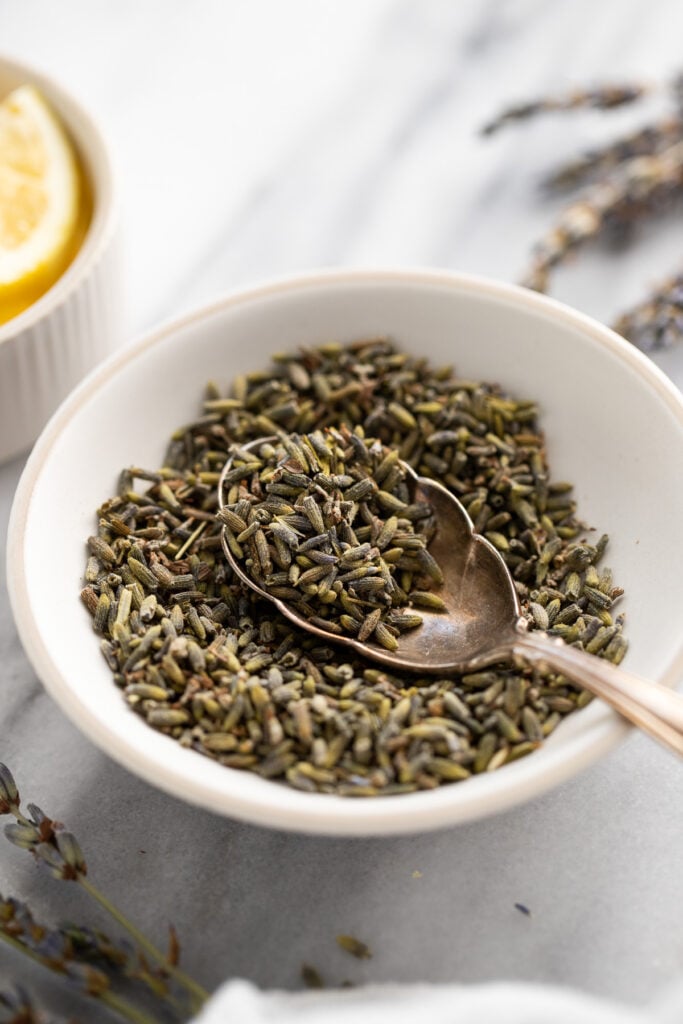
Tips for Baking with Dried Lavender
Until these scones, lavender played the role of help-me-calm-the-heck-down in my life. It was the essential oil I’d diffuse after a long day when I needed some relaxation, the one I’d drop in my bubble bath, the one I’d slather on my wrists when I couldn’t sleep.
But my friend, baking with lavender is so wonderful, too. It’s especially delicious in scones…and have you tried lavender coffee?!
If you haven’t baked with lavender before, these scones are the perfect place to start. They’re the best kind of “beginner scone” and “beginner lavender” recipe out there. Plus, I have some tips to help you find success in baking with lavender.
You must use a culinary (food) grade lavender when using lavender in baked goods, cocktails, and anything you’ll be eating.
- Less is more. Using dried culinary lavender infuses a lightly floral flavor throughout the recipe. It adds such a unique, comforting flavor, but if you use too much, it can quickly become overpowering. That’s when the soapy flavor comes in.
- Similarly, if you have super fresh dried lavender, or you’re new to the flavor, you may want to start with less until you find your perfect amount.
- There might be what look like little sticks mixed into your dried lavender, depending on the brand. You can remove the larger pieces as best you can but overall, the smaller ones will be fine.
The Key to Making Good Scones
There are really two keys to making good scones, so before we dive into the process, let’s cover them:
- Keep your ingredients COLD! The cold butter is the main ingredient that once baked, releases steam and creates the light, fluffy layers in the scones. If the ingredients are too cold, your scones will be flat and spread significantly.
- Grate frozen butter or simply cube the butter and keep it in the fridge or freezer while preparing the scones.
- Do not overwork the dough. There is a little kneading and folding to form the scones, but it’s important to not overdo it. Don’t work the dough too much or the scones will turn out tough, instead of their light, soft selves.
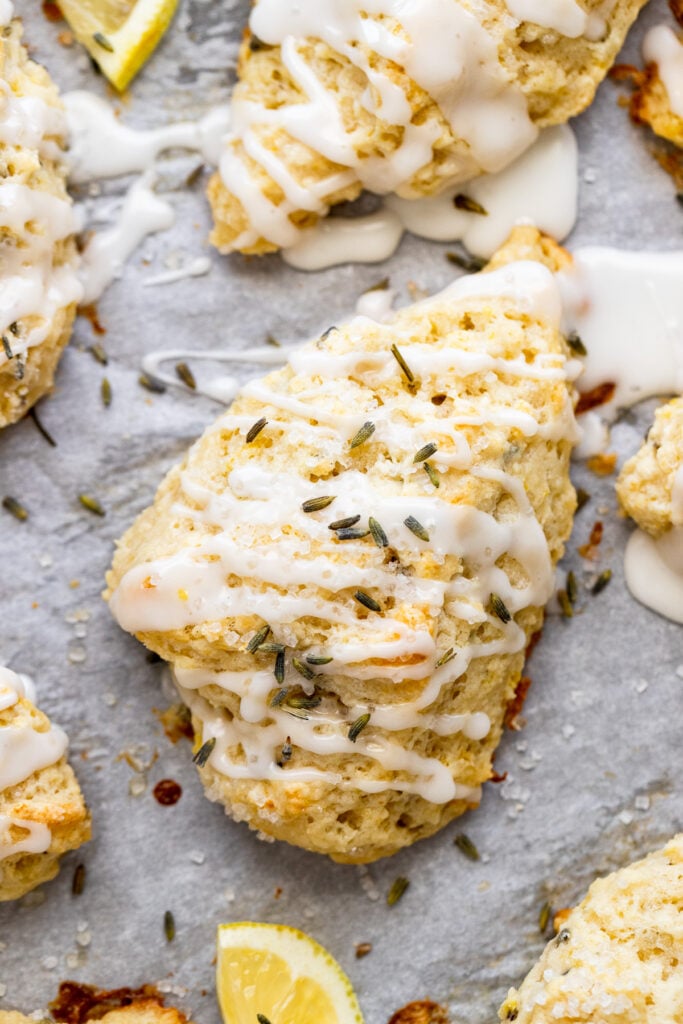
How to Make Lemon Lavender Scones
Scones can be intimidating to tackle; I hear you. I’m happy to report back that these scones are quite easy to make, and as long as you don’t have too much of a heavy hand when kneading, you’ll be met with layers inside your light, fluffy scones.
Here’s an overview with tips and tricks, please see the full recipe card below for all instructions and amounts.
Combine Sugar and Lemon Zest
When I’m making baked goods with lemon, the first order of business is rubbing together the granulated sugar and lemon zest.
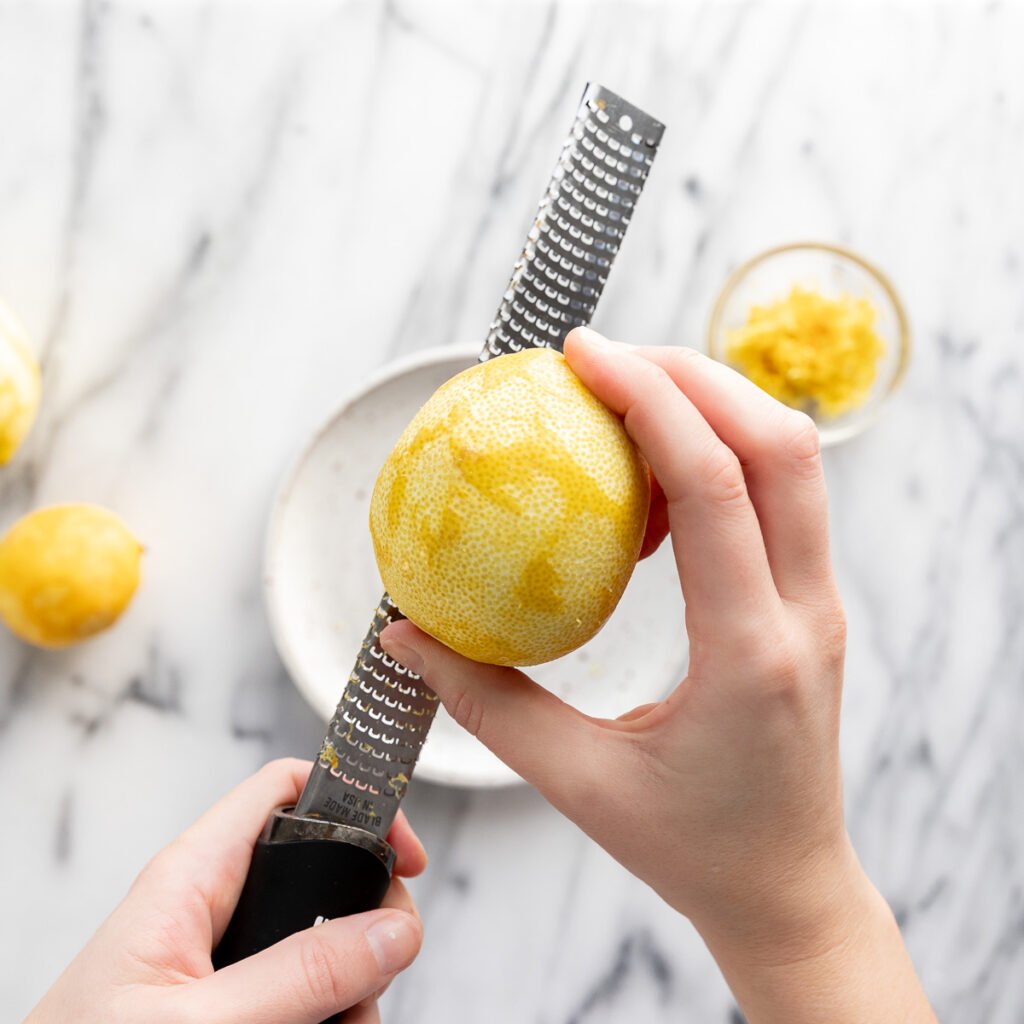
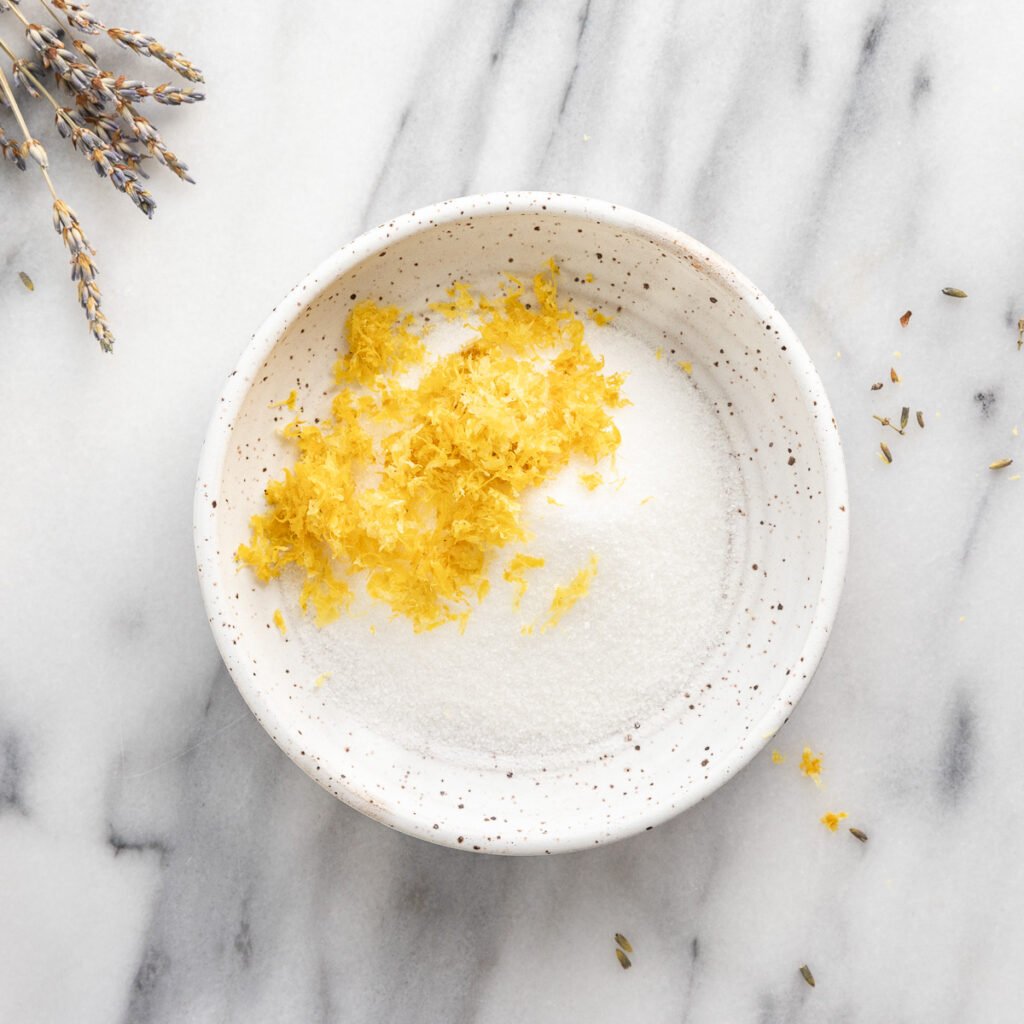
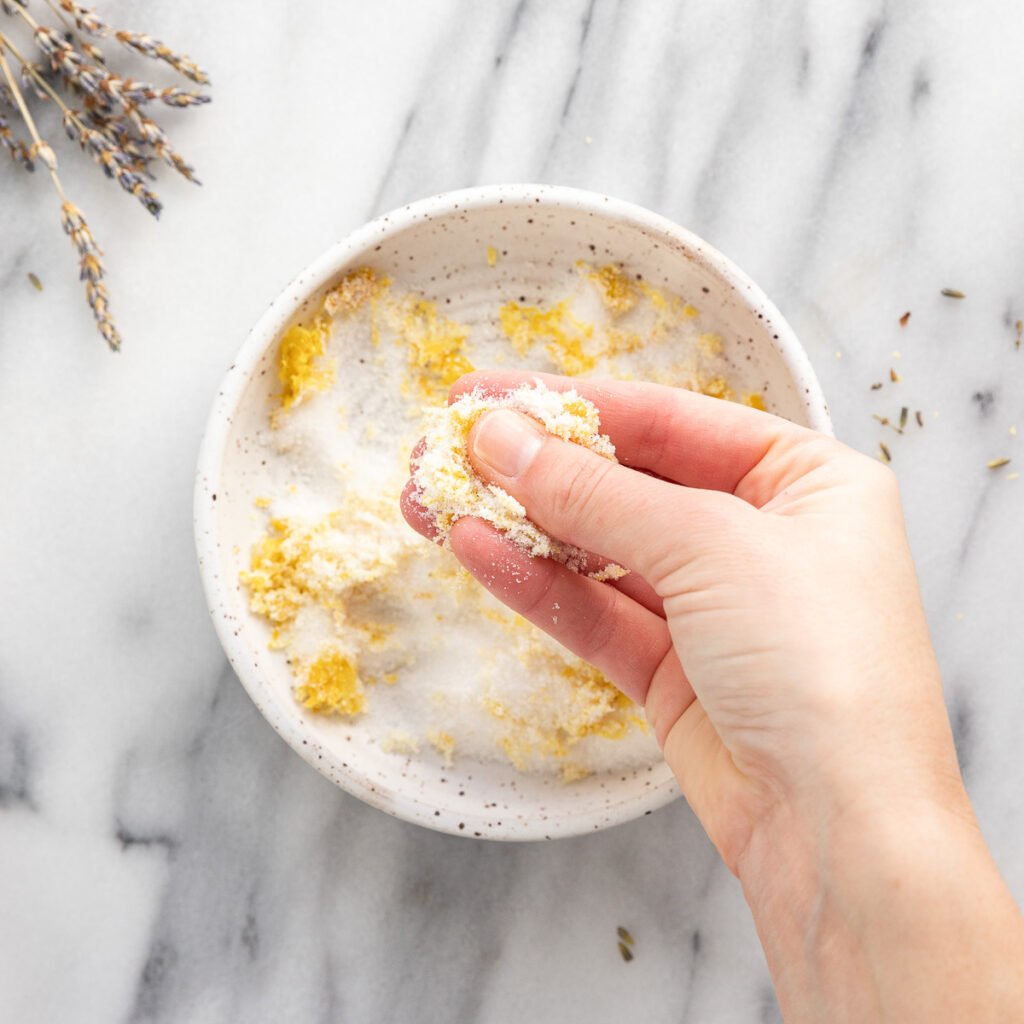
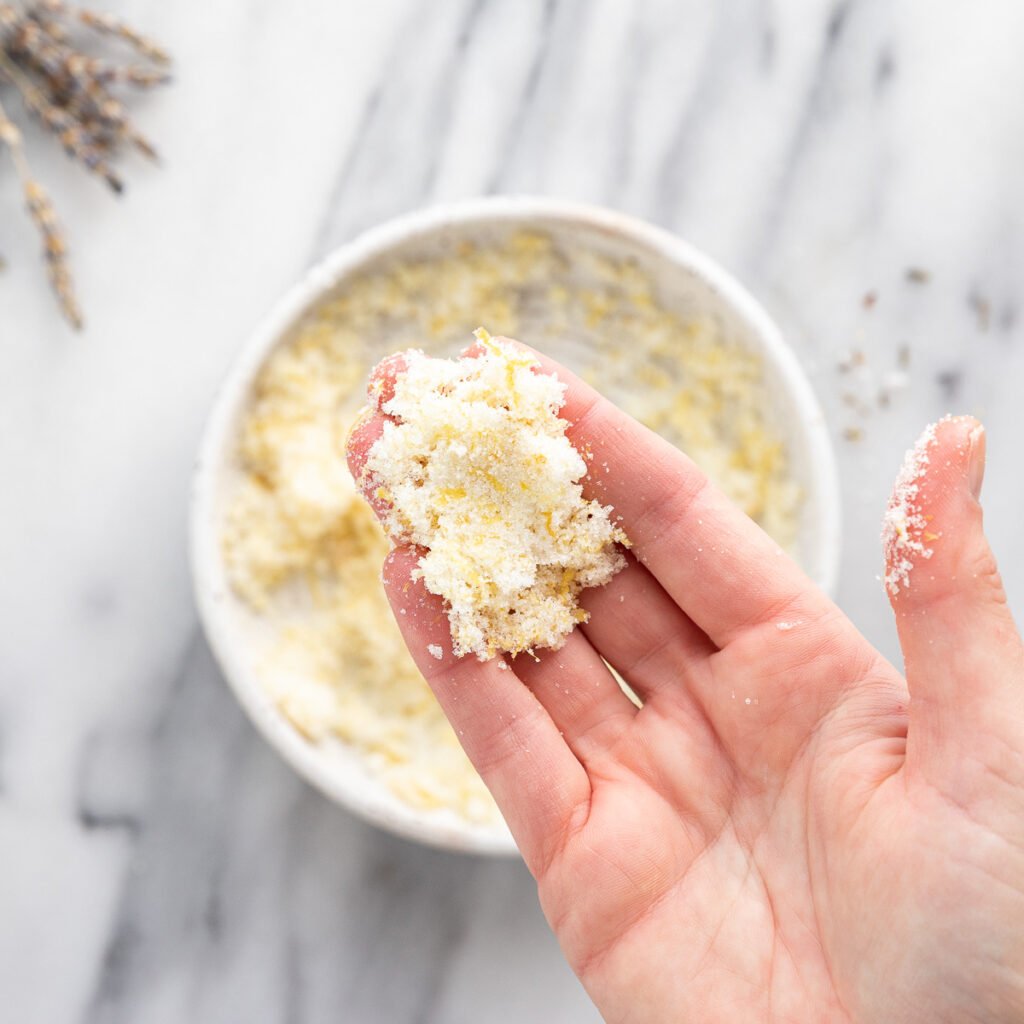
Lemon zest is a must because it holds so much bright flavor, and when it’s rubbed together with the sugar, the oils from the zest are released. This means there is SO MUCH more lemon infused throughout.
Simply rub the two together between your (clean!) fingers until it transforms into a sand-like mixture. You’ll also have a lovely citrus scent fill the air.

Mix Together the Liquids
Next up, stir together the milk, lemon juice, and vanilla extract. Mixing the milk with the lemon juice creates a “buttermilk” – giving the scones extra flavor and keeping them moist.
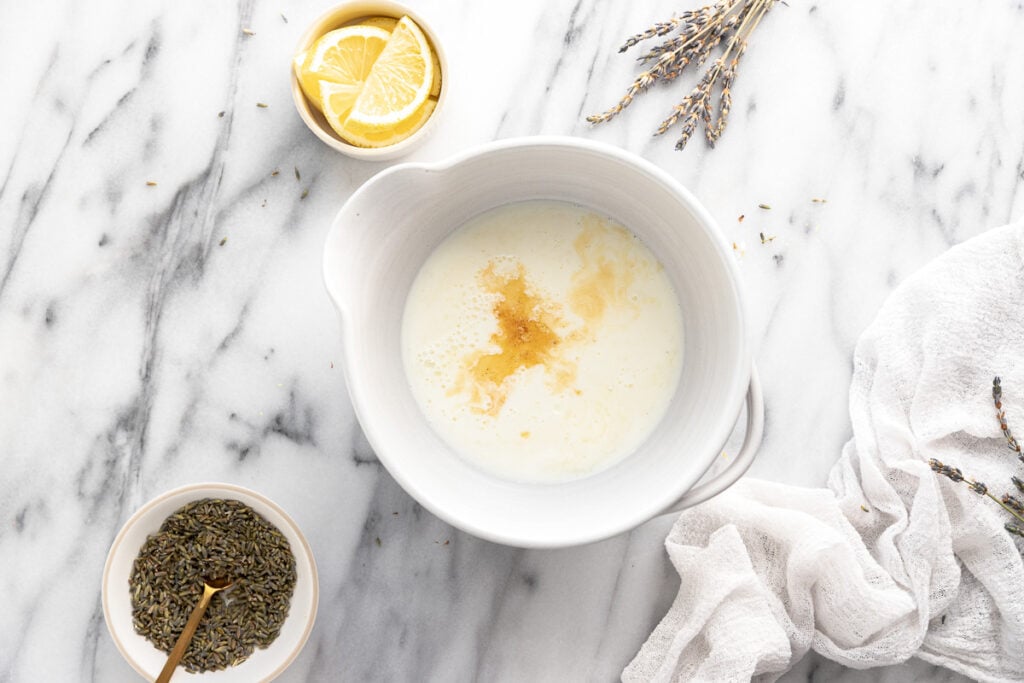
Place the mixture back in the fridge (cold ingredients!) and by the time you’re ready to use it in the dough, you’ll see it thickened and appears slightly curdled. That’s what you want! That’s the milk turning into “buttermilk”.
Make the Dough
In a large bowl, combine the all-purpose flour, baking powder, baking soda, salt, and dried lavender. Add the lemon-sugar mixture as well, and stir it until it’s combined.
Then, cut in the cold butter pieces until a pea-sized mixture forms.
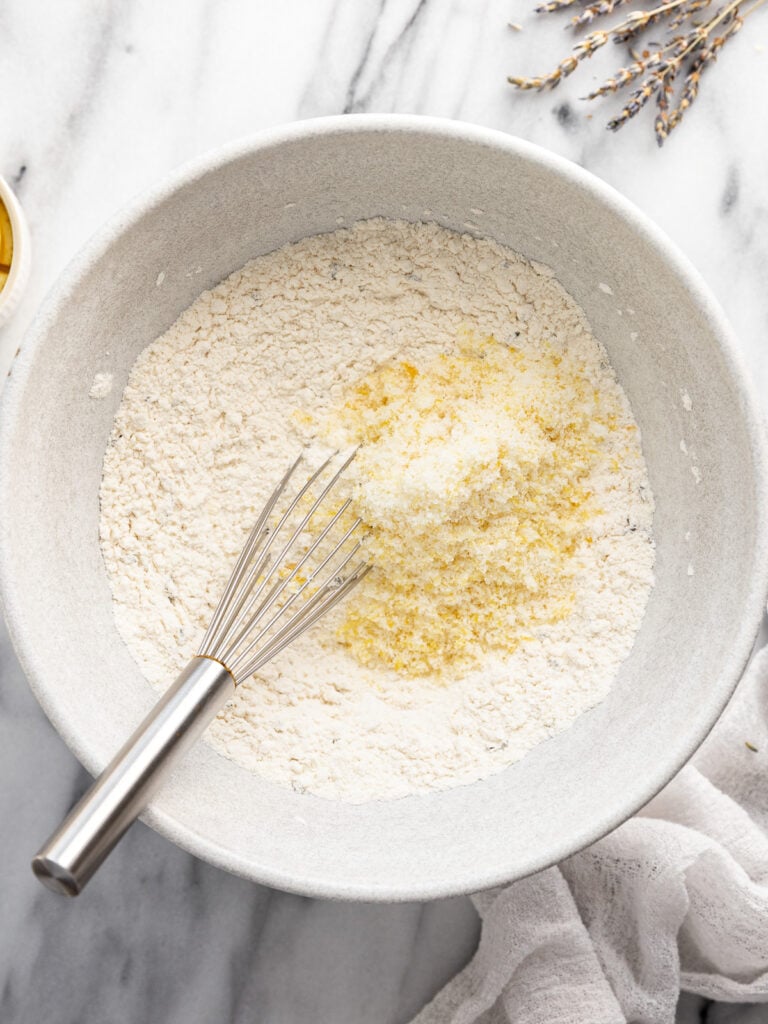
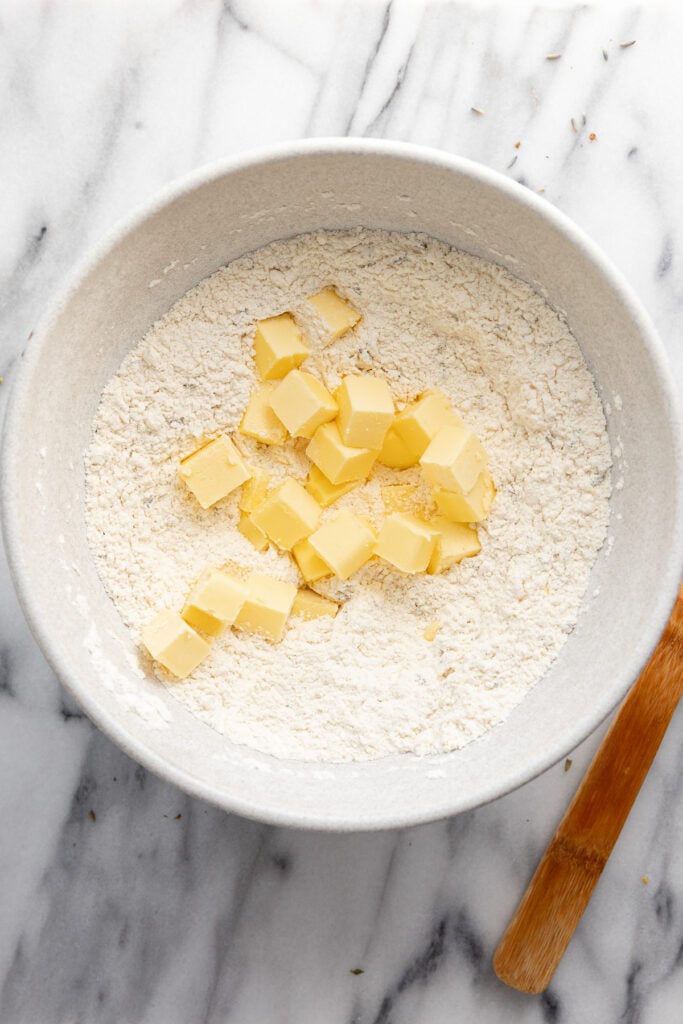
Cut in butter: this means using a pastry/dough blender, fork, or simply your hands, to press the butter into the flour. The smaller the butter pieces are to start, the faster they will be incorporated into the dry ingredients, and the less the scones will spread while baking.
If you are using your hands, I recommend sticking the mixture back into the fridge before proceeding, since your hands will have warmed the butter.
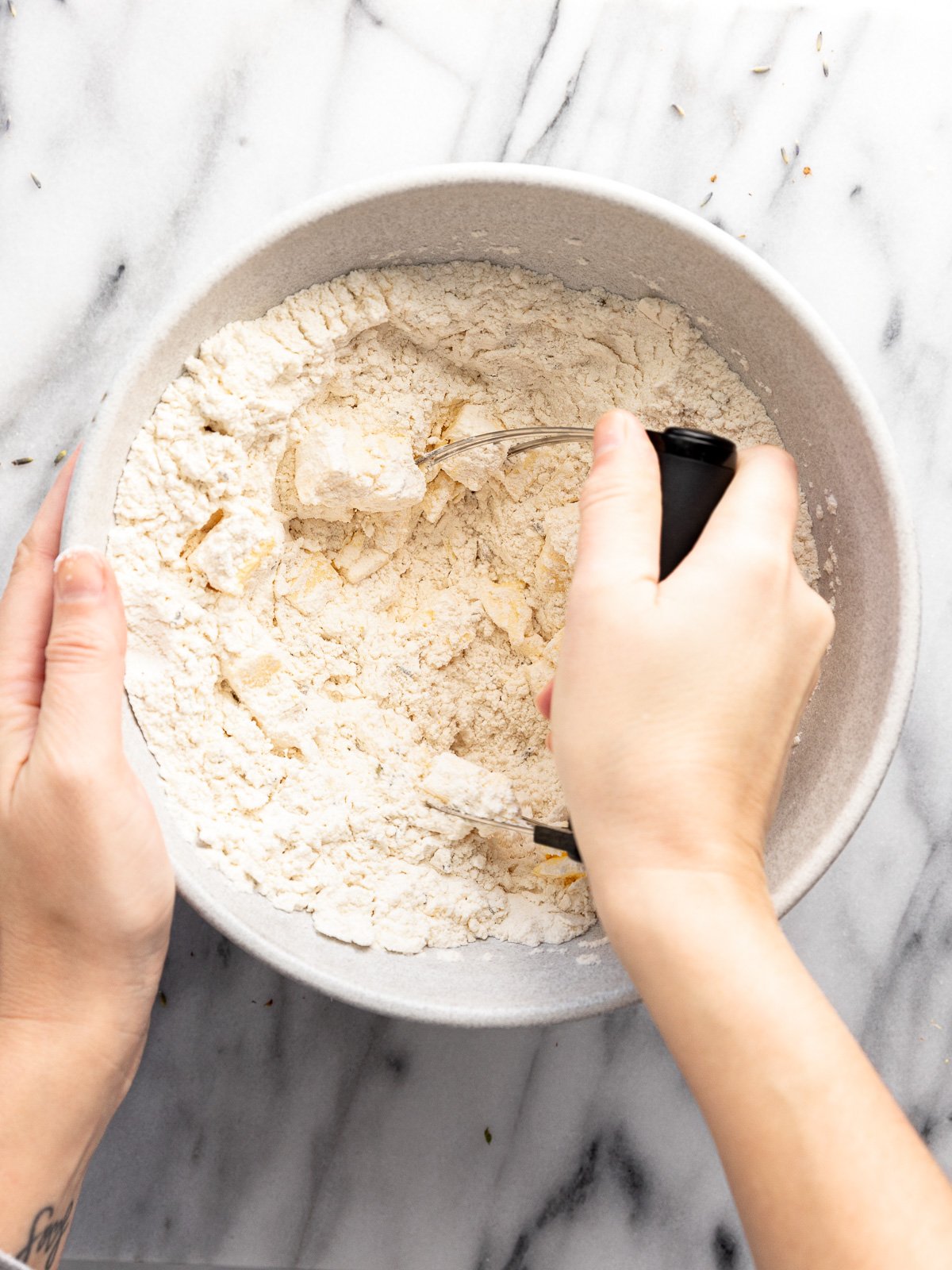
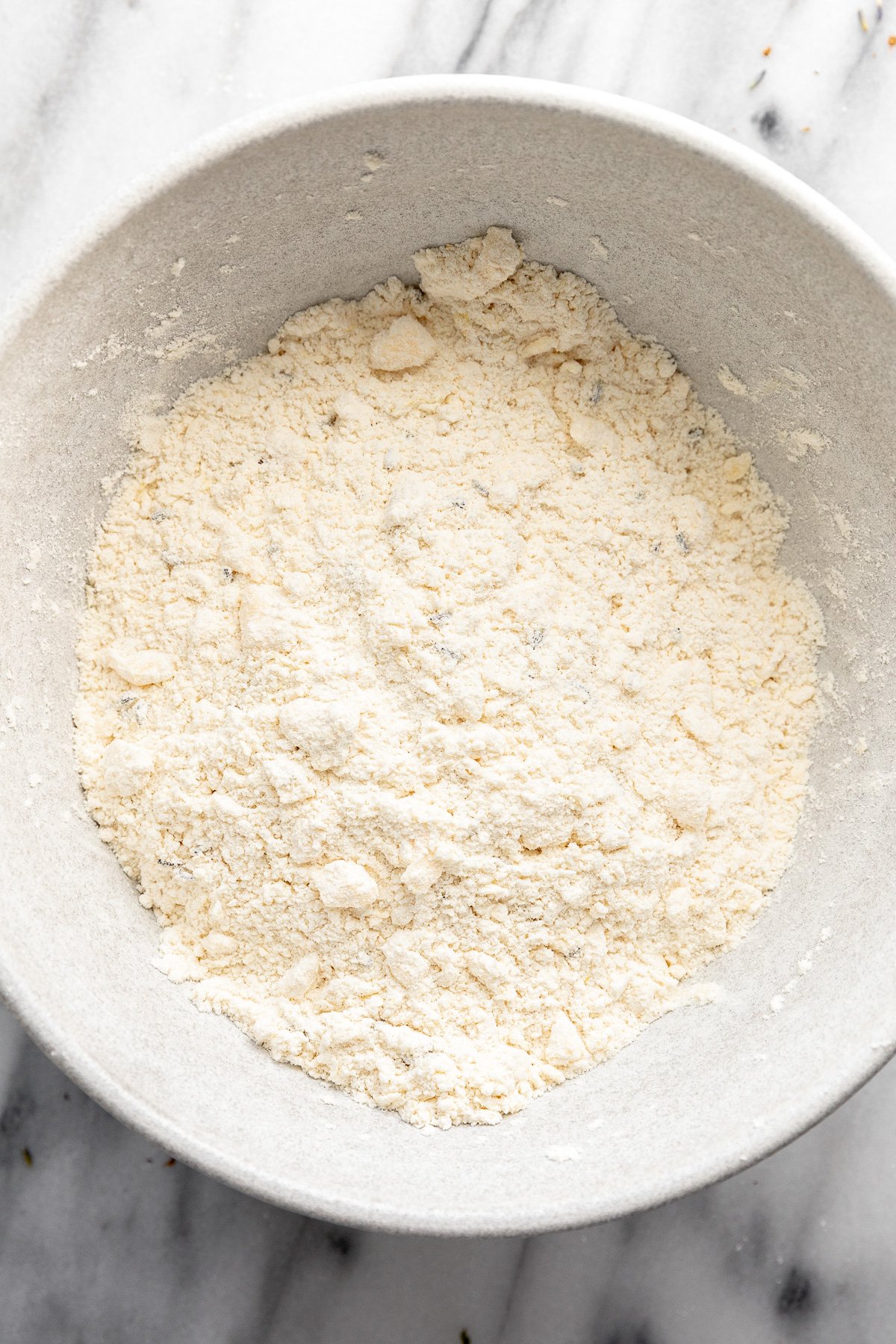
Once the butter is incorporated, gently stir the cold milk mixture in until just combined.
Remember, it’s important to not overmix throughout this entire process! Once the mixture is moist, transfer the dough to a clean work surface lightly coated with flour.
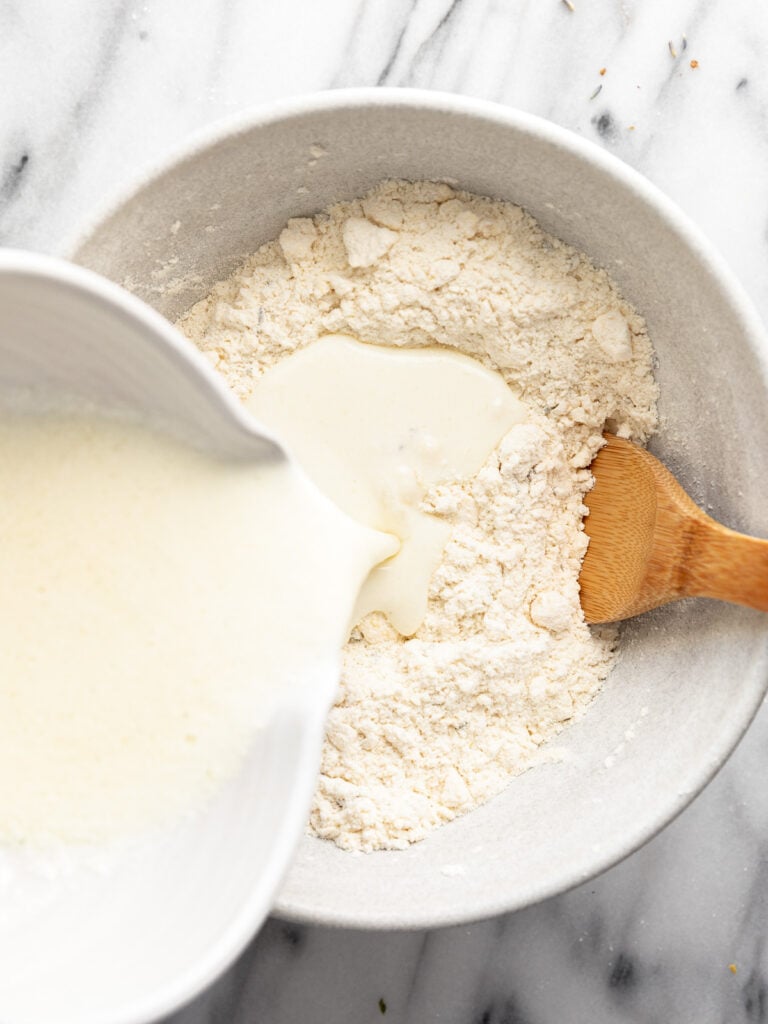
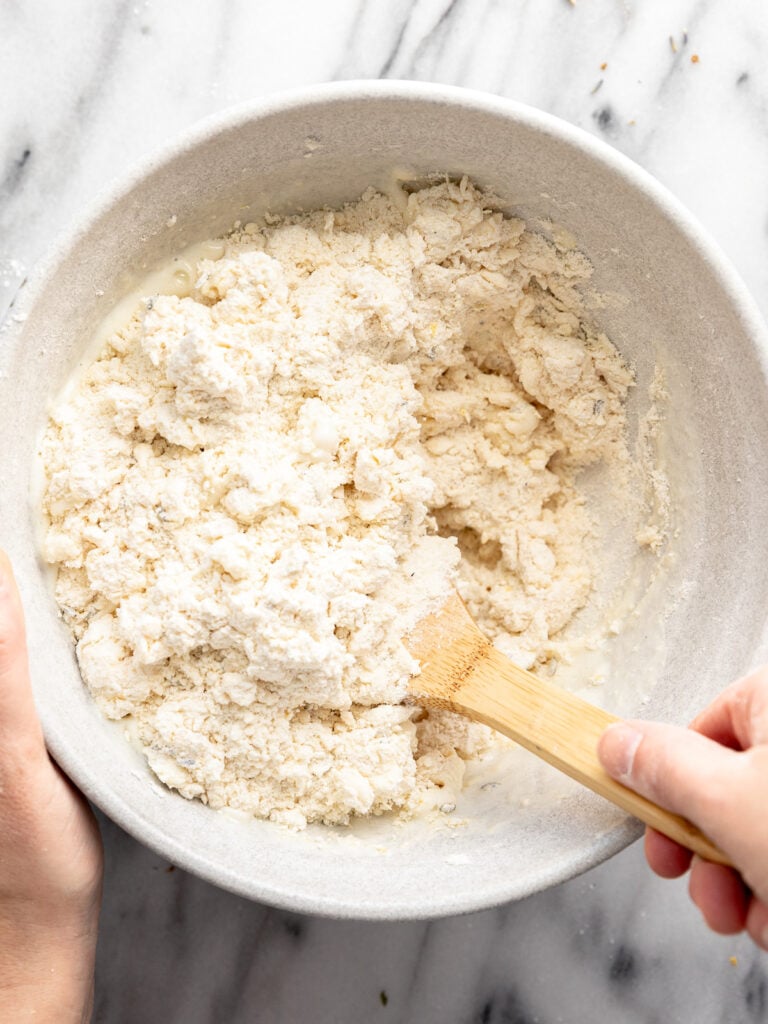
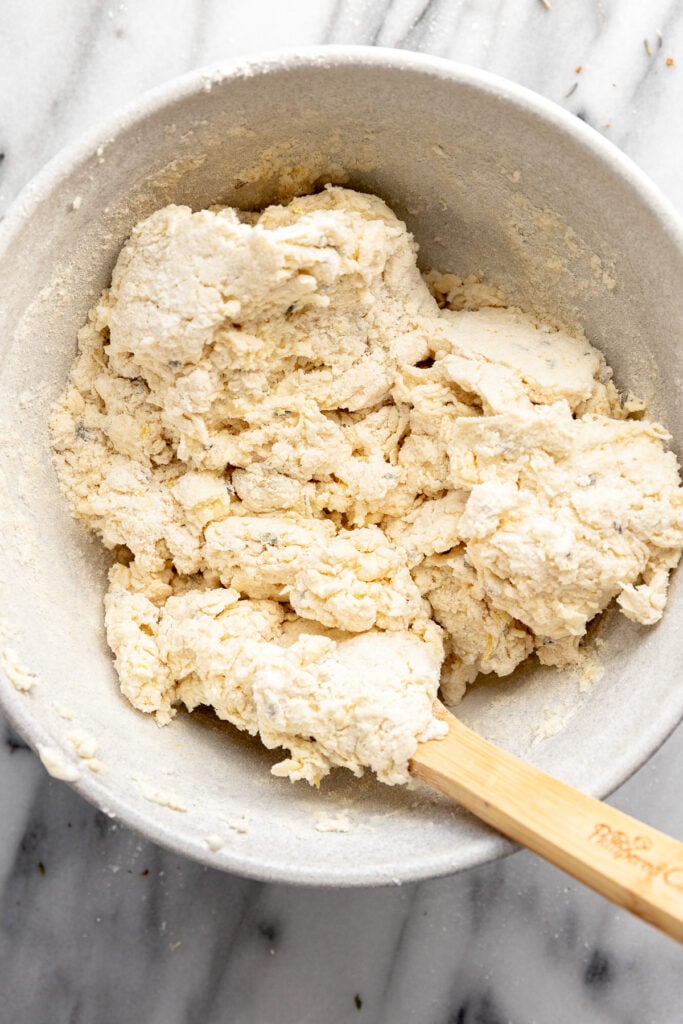
Form the Scones
With the dough transferred to your lightly floured work surface, gently form the dough together into a ball. If it’s sticky, use floured hands or lightly sprinkle flour across the top of the dough.
I recommend folding the dough for the most rise. Press the dough into a rectangle, then fold the sides in thirds, horizontally, like you’re folding a piece of paper to make a pamphlet. Then, press it back down into a rectangle that is approximately 8 inches by 5 inches.
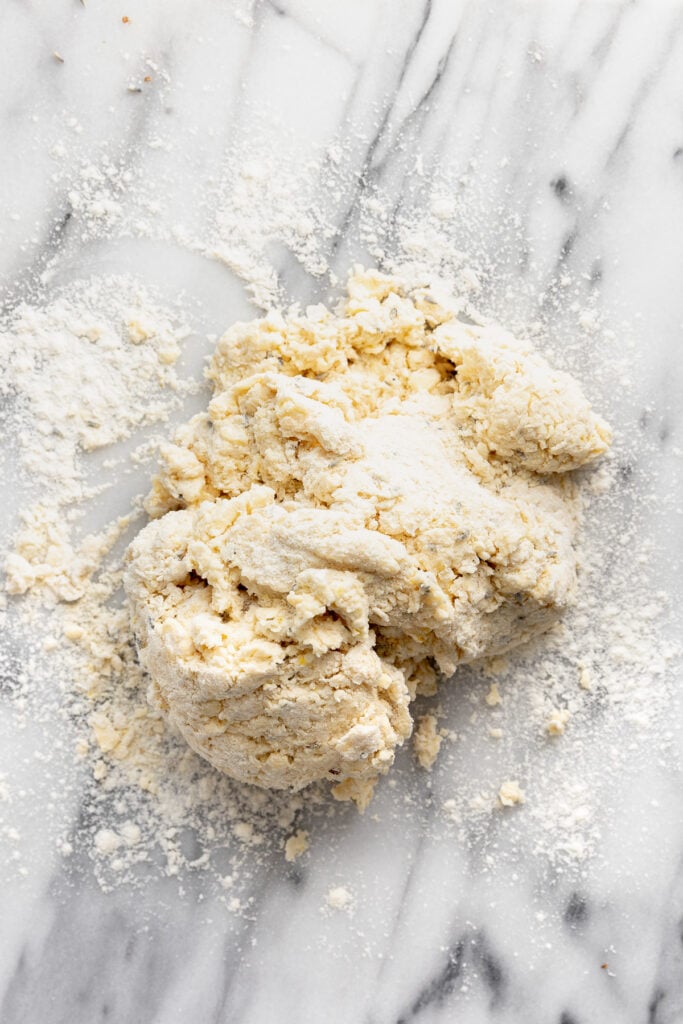
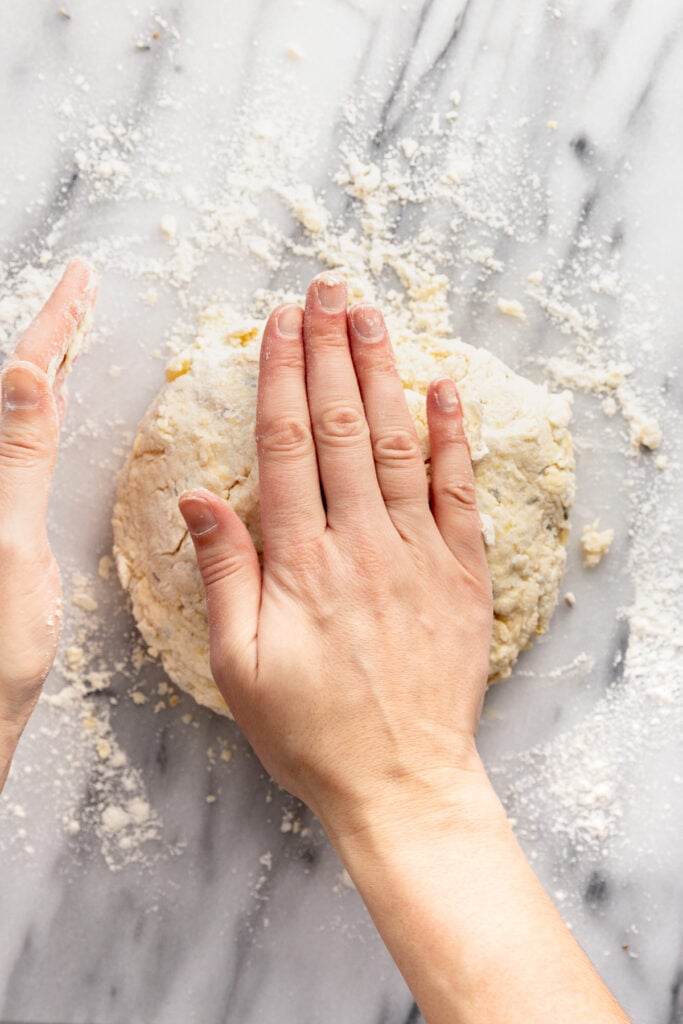
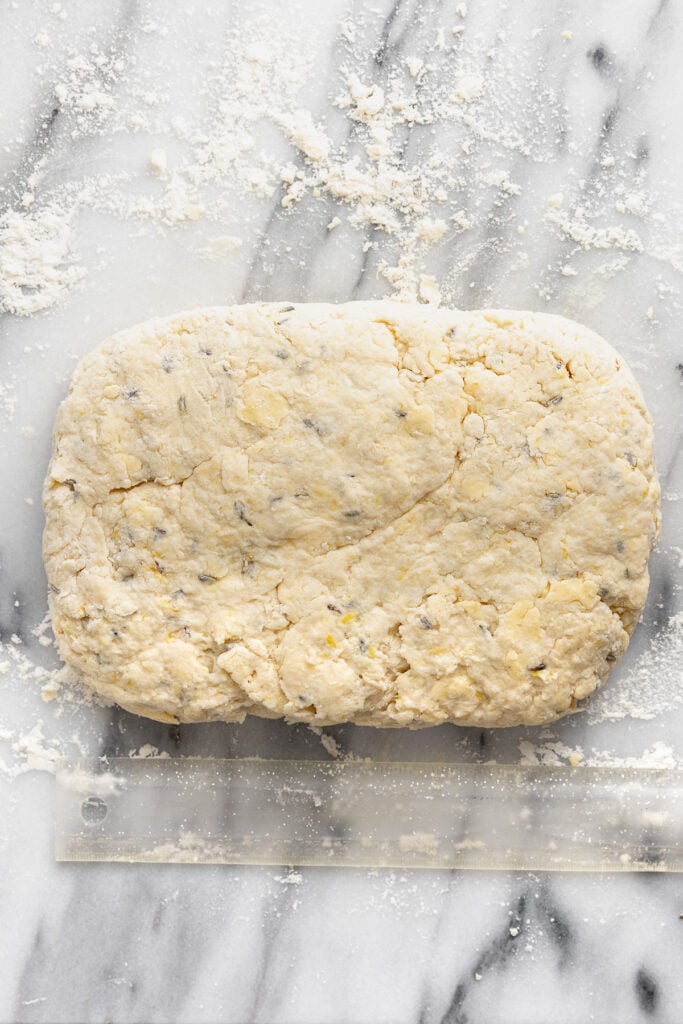
The folding process also helps form the dough together without working the dough too much.
Cut the rectangle horizontally down the center. Then, make two verticle cuts so you’ve sliced the rectangle into thirds. You’ll now have 6 smaller squares. Cut each square in half to make two triangles, and you’ll have 12 small triangles.
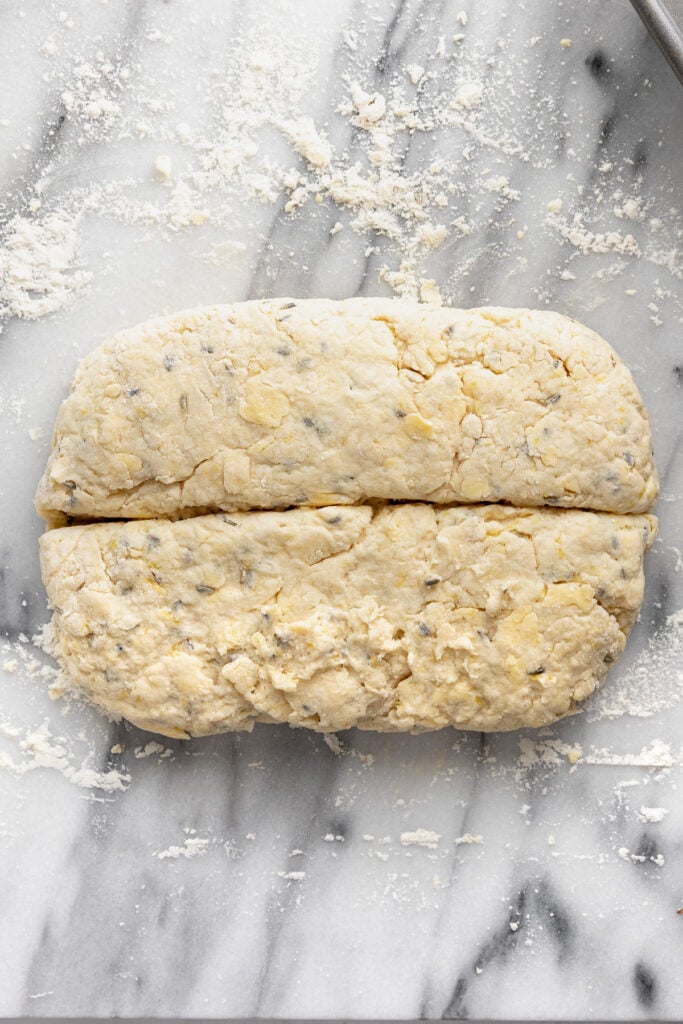
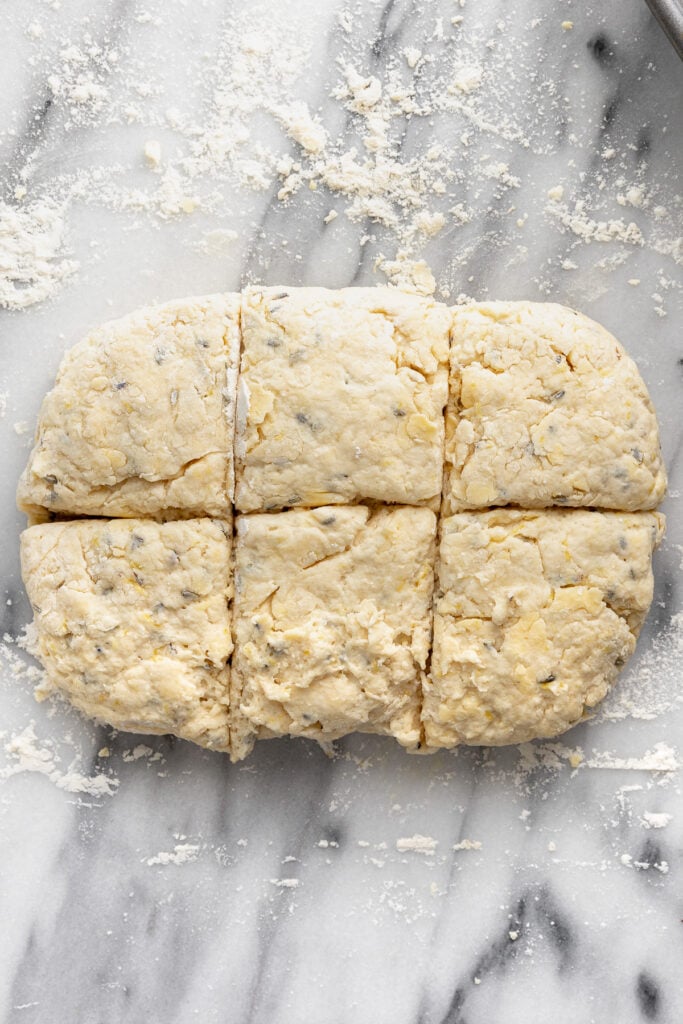
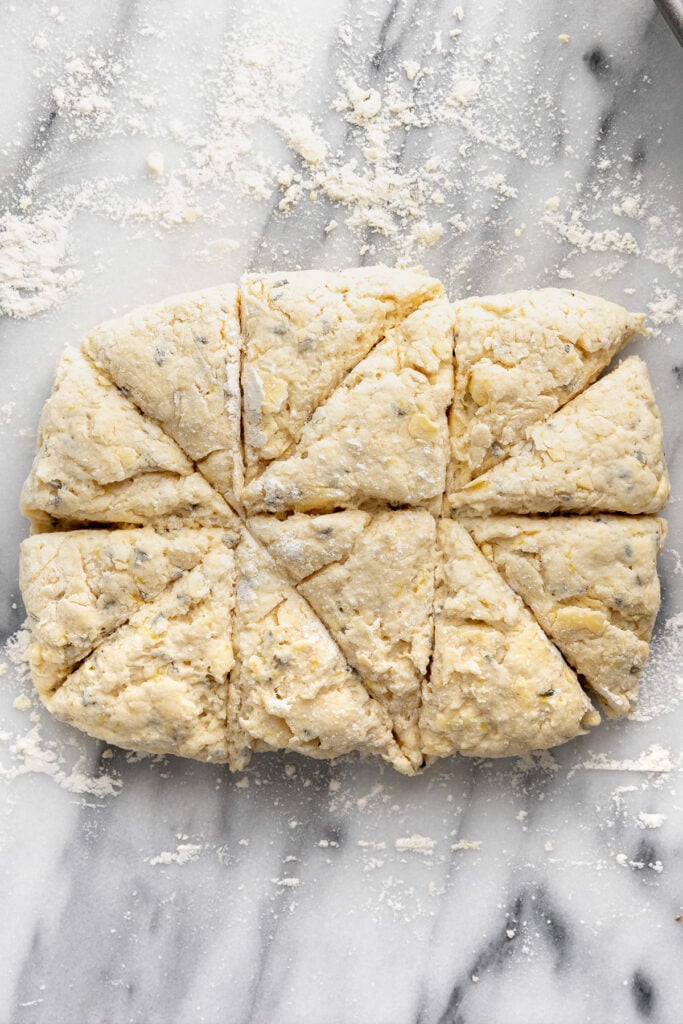
If the knife is sticking to the dough, dip it in flour or flour the top of the dough before cutting.
You can also form the dough into one large or two smaller discs and cut the triangles that way if you prefer.
For best results, place the prepared scones in the fridge or freezer for 20 minutes before baking.
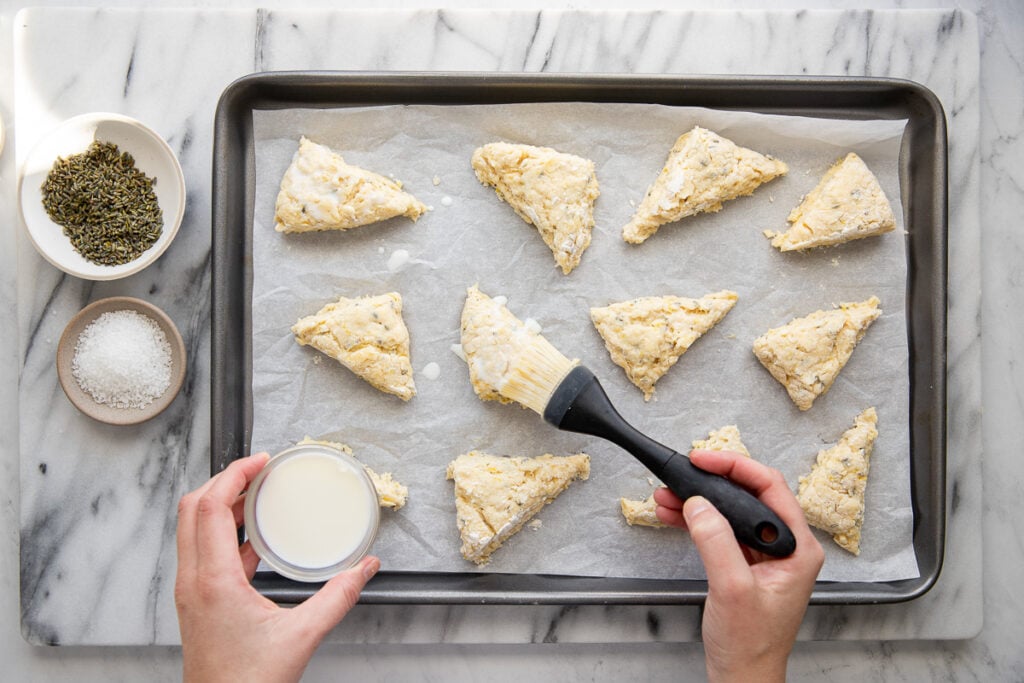
Bake the Scones
Place the cut wedges on a baking sheet lined with parchment paper, leaving at least 2-3 inches between each scone so it has room to expand. Brush the tops of the scones evenly with milk to help the exterior turn a lovely golden brown.
At this point, if using, sprinkle with coarse sugar. It’s so pretty and a perfect alternative to using icing.
Bake the scones for 19-22 minutes until the bottoms and tops are slightly golden brown. Once baked, allow the scones to cool slightly before transferring them to a cooling rack.
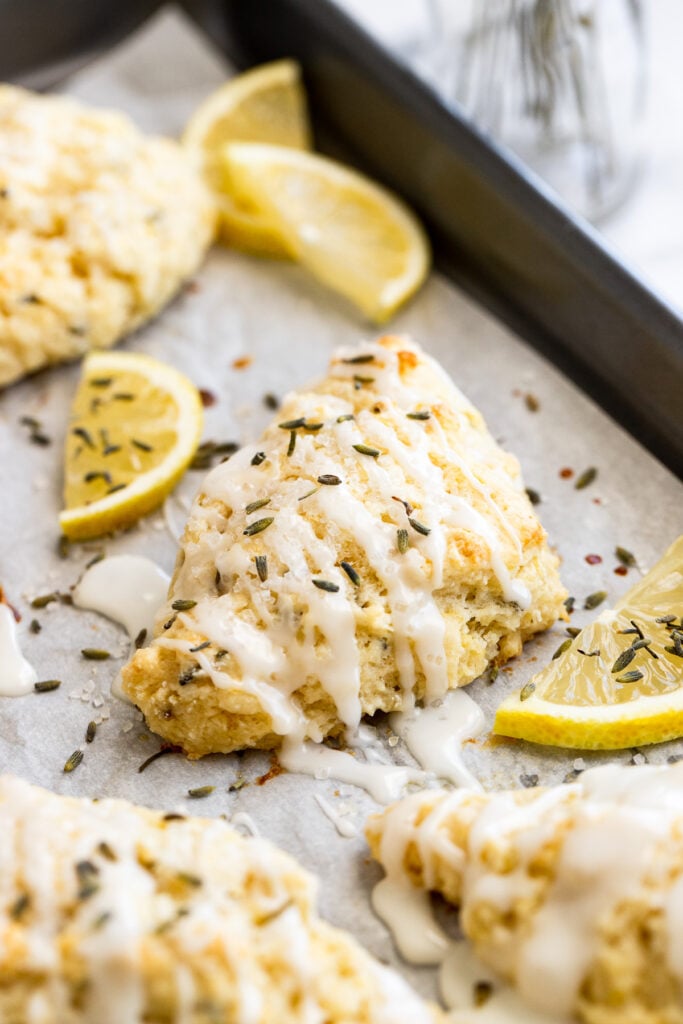
Icing for Scones
While the icing isn’t required for the scones, it is absolutely delicious, gorgeous, and feels extra special.
To add to the bright lemon flavor of the scones, make a lemon icing by combining powdered sugar and fresh lemon juice, plus lemon zest.
Otherwise, use milk or cream in place of the lemon juice for a subtly sweet icing. This lets the flavor of the scones shine through.
Stir together until a thick, but drizzle-able consistency is achieved. You may need to adjust depending on your preferences, adding more powdered sugar to thicken, and more liquid to thin it out.
Drizzle on top of cooled scones, et voila, you’re ready to enjoy!
Serving, Storage, And Making Ahead
Alright, the good news is that you do not have to wait for the scones to cool completely before serving. In fact, I love them when they’re still slightly warm and fresh (the best!). But then again, who doesn’t love warm baked treats?!
I will say they are best on the day of baking, but you can make them the day ahead if needed. The longer they sit (2-3 days), they do tend to dry out. That’s best remedied by reheating them quickly in the microwave.
I recommend not icing more than 1-2 hours in advance before serving. If left overnight, the icing does “melt” into the scones and isn’t quite as pretty.
To store leftover scones, place them in an airtight container at room temperature, for up to 3 days.
One more idea…
Dare I say…dessert? I’m thinking of warm scones topped with a scoop of ice cream. Maybe lavender ice cream? Drizzled with honey and lavender syrup? Then toss in some fresh blueberries with fresh mint leaves. Holy cow, I think we just perfected a light, spring-summer dessert.
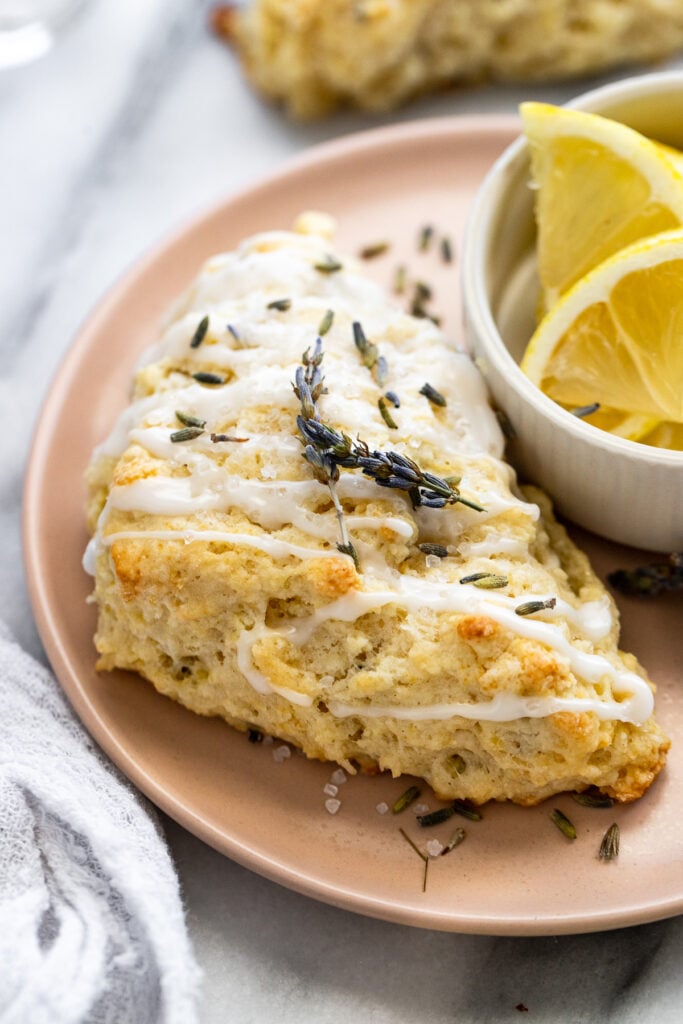
Freezing Tips
The beauty of this recipe is that the scones freeze well both before and after baking!
- Freeze Before Baking: Do not brush with milk. Freeze the scones spread apart on a baking sheet, for 1-2 hours. Once they’re frozen, transfer them to an airtight, freezer-safe bag for bulk storage. You can bake them from frozen, adding a few minutes to the cooking time, or thaw them overnight in the fridge.
- Freeze After Baking: Do not drizzle the scones with icing if you plan on freezing them after baking. Let them cool completely before freezing. Place them in a freezer-safe bag or airtight container. Thaw at room temperature for a few hours, or place in the microwave on defrost for about 1 minute. You can also warm a batch in the oven at 275°F for 10-12 minutes.
Did you make this recipe? Please leave a star rating and review in the form below. I appreciate your feedback, and it helps others, too!
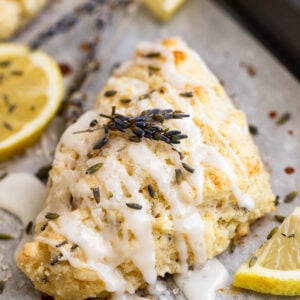
Get the Recipe Lemon Lavender Scones
Ingredients
- 1/2 cup COLD butter, 1 stick, small cubed, see notes
- 1/4 cup (55 g) granulated sugar
- 2 Tablespoons lemon zest, ~3 lemons
- 3/4 cup milk + more for brushing
- 1/4 cup fresh lemon juice
- 1/2 teaspoon vanilla extract
- 2 1/2 cups (320 g) all-purpose flour
- 1 Tablespoon baking powder
- 1/2 teaspoon baking soda
- 1/2 teaspoon fine sea salt
- 2 1/2 teaspoons (1 g) dried culinary grade lavender flowers
ICING:
- 1 cup powdered sugar
- 1 – 1 ½ Tablespoons milk, sub with lemon juice for extra lemon flavor – but don’t use both
- 1 teaspoon lemon zest, optional
Instructions
- Preheat the oven to 375°F and line a large baking sheet with parchment paper. Cut the butter into small cubes now and place in the fridge or freezer. Alternatively, grate frozen butter and place back in the freezer until ready to use.1/2 cup COLD butter
- In a small bowl, combine sugar and lemon zest, rubbing between your clean fingers until a coarse, wet sand-like mixture forms. This step helps infuse the lemon flavor!1/4 cup granulated sugar, 2 Tablespoons lemon zest
- In a separate bowl, combine milk, lemon juice, and vanilla extract. This will form a "buttermilk" like consistency. Place it in the fridge until you're ready to use so it stays cold.3/4 cup milk + more for brushing, 1/4 cup fresh lemon juice, 1/2 teaspoon vanilla extract
- In a large bowl, whisk together the flour, baking powder, baking soda, salt, dried lavender, and the lemon-sugar mixture.2 1/2 cups all-purpose flour, 1 Tablespoon baking powder, 1/2 teaspoon baking soda, 1/2 teaspoon fine sea salt, 2 1/2 teaspoons dried culinary grade lavender flowers
- Cut the cold butter cubes (or grates) into the flour mixture until a small, pea-sized mixture forms. If needed, you can use your fingers to press it together, but if so, put it back int he fridge to chill the dough before proceeding. You want the dough as cold as possible.
- Gently stir the milk mixture into the flour until just combined and everything is moist. Do not overmix or you'll end up with tough scones.
- Transfer the dough to a lightly floured surface and gently form it together into a ball. Again, do not over-knead it, just gently push the dough together. Press it into a rectangle and fold the two horizontal sides over each other, as though you're folding a pamphlet. This will help form layers.
- Then, press the dough into an 8 x 5 inch rectangle. Cut the rectangle down the middle, lengthwise, to have two long rectangles.
- Then make two horizontal cuts, into thirds horizontally, to create 6 squares.
- Cut each square in half diagonally to form two triangles. This will result in 12 small triangles.
- Use a thin spatula to transfer the scones to the baking sheet. Leave plenty of space in between each one, around 2-3 inches (they will expand when they bake). Brush the tops and sides of the scones evenly with a bit of additional milk to add color as they bake. If using coarse sugar to top, sprinkle on now.
- Bake the scones for 18-22 minutes until the bottoms and tops are slightly golden brown. Remove and let cool slightly before transferring to a cooling rack to cool completely.
- Icing (optional, but recommended): Stir together powdered sugar, milk (or lemon juice & zest, if substituting it), until combined into a thick but drizzle-able icing. Drizzle on cooled scones and enjoy!1 cup powdered sugar, 1 – 1 ½ Tablespoons milk, 1 teaspoon lemon zest
- Store leftovers in an airtight container at room temperature for up to 3 days, or see the notes below for freezing.
Notes
- Cold Ingredients: Keep all ingredients cold, especially the butter! Cut it into small cubes before beginning the process, and store it in the fridge or freezer. You can also grate frozen butter to spend less time cutting it into the dough.
- Food Processor: You can use a food processor, just be sure to not overwork the dough. The food processor tends to chop the lavender up more, so I like to add a little extra if I’m making the scones this way.
- Freezing: they freeze well before and after baking.
- Before Baking: Do not brush with milk. Freeze the scones spread apart on a baking sheet, for 1-2 hours. Once they’re frozen, transfer them to an airtight, freezer-safe bag for bulk storage. You can bake them from frozen, adding a few minutes to the cooking time, or thaw them overnight in the fridge.
- After Baking: Do not drizzle the scones with icing if you plan on freezing them after baking. Let them cool completely before freezing. Place them in a freezer-safe bag or airtight container. Thaw at room temperature for a few hours, or place in the microwave on defrost for about 1 minute. You can also warm a batch in the oven at 275°F for 10-12 minutes.

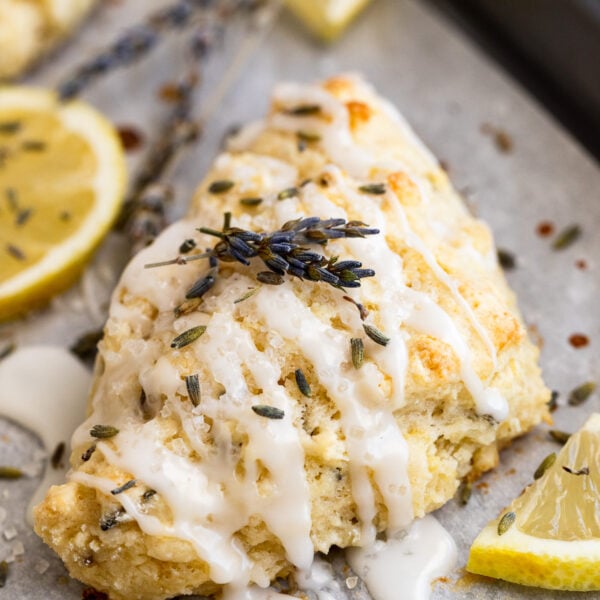



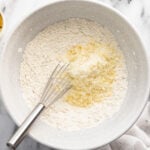
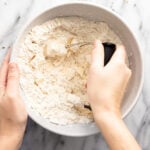
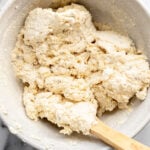

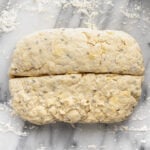
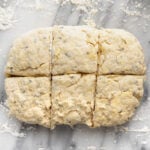
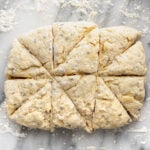

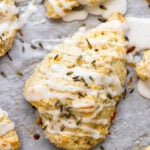



Mmmmm lemon and lavender – that combo sounds just magical! I absolutely adore scones, but for some reason I haven’t made them in quite a while. That certainly needs to change ASAP!
Agree! For some reason I don’t get around to making them often but they’re so good! That’s definitely changing now!
Recipe is great however when do you add the lemon sugar to the mix? The first time I made it I forgot to add the lemon sugar and just used it for the icing on top. I am making them again and added lavender flowers to the lemon sugar and planning on adding it the same time I add the lavender.
Katie – I am so sorry I left that key step out of the directions! I updated the recipe – I add the sugar mixture to the flour right before I cut in the butter. I’m glad to hear you’re making them again! 🙂 Enjoy!
Can you double the recipe? Sometimes when baking you can’t double. Have you tried it with this recipe?
Hi Jody! I haven’t tried doubling this recipe myself, I’d just recommend being careful to not overwork the dough still. You could also cut the dough into smaller triangles if you’re looking for a smaller bite to feed a crowd (and likely reduce baking time if you do make them smaller!). Let me know how it turns out!
I doubled the recipe and they came out wonderful. The only thing I had a hard time with was blending the butter. It took longer, should’ve used food processor.
Highly recommend making scones!
Yay! So glad it worked out! 🙂
These were so pretty and delicious!
I shared with friends so that I wouldn’t devour them all.
I’m so happy to hear, Shelly! I’m glad your friends were able to enjoy them, too! 🙂
Hi Becca,
Thanks so much for sharing this recipe. I made them today for the first time and they came out great! Definitely will make these again. I started growing lavender for tea and aromatherapy but this was the first time I baked with it.
I’m so happy to hear you enjoyed them, Theresa! I LOVE that you used your own lavender!
Replaced butter for vegan butter based on almond oil and milk with almond milk! Turned out amazing!!!!
Ana, I am so glad to hear they were amazing with vegan butter and almond milk! Helpful tip for others making the recipe, too, thank you for sharing! <3
Hi! I clicked on the link you provided for the lavender flowers. I’m wondering, if you used those exact ones, did you have to pick out the lavender buds from the other little bits and pieces of the plant? Someone commented on Amazon that the lavender they normally buy doesn’t have that stuff in it and it was almost impossible to bake with these because of the “debris”. Do you just throw it all in the scone? Thanks!
Hi Brittney! Great question. I do use the lavender linked in the post. There are some larger “stick-like” pieces that I remove when baking with it, but it hasn’t ever been much of a problem for me. Are you on Instagram? I’d be happy to show you what it’s like. Send me a DM if you are and I’ll send over a video. Otherwise, happy to send one via email if it’d be helpful.
Nice. With safer at home, I have been doing a lot of baking with my children and we started 3:00 tea. Experimenting with different flavors for scones, we found this. As a side note, Lavender is very easy to grow and can be grown indoors or outdoors. A few years ago I stared infusing my sugar with lavender from my deck pots.
I love 3:00 tea! That’s such a fun idea with your kids, I’m so glad these Lemon Lavender Scones were part of it – and homemade lavender – YES!
These where AMAZING! I added some extra vanilla to the glaze along with a drop of Lavender essential oil. They where so light a crispy!
Yum, yum, yum! That sounds amazing. I’m so glad you enjoyed, Adeline. Thanks for commenting!
Loved your recipe. This was my first attempt at making scones. Very similar to my homemade biscuit recipe (as in technique). They’re all gone! I had to share with my neighbors so my husband and I wouldn’t eat them all, and they all said they were amazing!
Hi Amber – it’s definitely a similar technique, I’m so glad you gave it a try for the first time! And so so happy to hear everyone loved them! 🙂 It’s such a fun flavor. Thank you for commenting, and trying out the recipe!
Can I halve the recipe? I want to try to make less of it to see if I like it cause I’m not used to lavender being in a scone but still want to try because I love the flavor.
Hi Veronica – I haven’t halved the recipe myself but I don’t see why you wouldn’t be able to. I’d love to hear what you think once you try them!
Hi Veronica, I’m wondering if you tried halving the recipe and what your results were? Thank you!
I made these and appreciated the tips about keeping the butter in the fridge after cubing it. I just saw another recipe where they froze the butter and then grated it. May try that too.
Everything came together easily enough. For me, the lavender taste was a bit strong, so I may halve the amount and try again. I’m in search of a lavender scone recipe to include in my cozy mystery, as it takes place on a lavender farm in Cornwall! Glad I found yours.
Hi Kathy – I’ve heard of the grating frozen butter trick too, have yet to try it so thanks for the reminder! I’m glad to hear you enjoyed the scones, thank you for commenting!
This recepie is amazing! I adapted slightly but it worked perfectly!
My boyfriend was not sure about lavender and lemon and it turn outs that he love them and now ask me to do them severas times! Perfect recepie to impress anyone! Classic but out of ordinary!
Really recomend you to do this!
I’m so glad to hear, Diana! Also glad they passed the boyfriend test 😉 Thanks so much for sharing!
These are SOOOOO delicious!!! Have quickly become a family favorite!
So glad to hear, thanks, Liz!
Delicious scones! Nice combination of the lemon and lavender. the flavors came through, but were not overwhelming. I used the zest of a small lemon and the juice from the same lemon which turned out to be just right. I didn’t have enough leftover lemon juice for the icing, however,I crumbled some lavender buds into the icing.
.
I’m so glad you enjoyed! Thanks, Nena! I bet the lavender buds in the icing were beautiful.
I tried making scones for the first time yesterday after reading dozens of different recipes so I could get an overview of how it’s done. I grated frozen butter and then put it back in the freezer until it was time to mix in. I never did get the pea size mix everyone talked about but it still worked. My husband loved them!
I must try the grated butter trick, I still have to! So glad to hear it worked. Thanks, Belinda!
Hi Becca, I have not tried the scones yet, but have a question about the milk. Can I use skim milk? Thanks
Hi Linda! Yes, you can use skim milk. Let me know how they turn out! ☺️
Simply Divine………the only problem is I made 12 for party, but only delivered 9 – they were too yummy to resist. Absolutely delicious, and so easy too!! Thanks and I’ll be sure to double up the next time 🙂
Haha! I completely understand that delimma 😉 I’m so glad you enjoyed! Thank you so much for commenting, Patricia!
The best lemon lavender scones I’ve ever made !! She provided perfect tips to make them nice and fluffy. Highly recommend this recipe.
Thank you so much, Crystal! I’m so glad you found the tips helpful.
I’m a very beginner baker. This recipe was so easy to follow and it tasted great. Perfect for the weekend!
I’m so glad to hear! Thanks, Clarissa!
Absolutely perfect! Everyone loved them. Thank you!
I’m so glad to hear! Thanks, Dawn!
Absolutely delicious! Light, perfect flavoring so it doesn’t overpower the senses, and so fun to bake! I keep my butter in the freezer. I use the food processor to grate it and then stick it back in the freezer until I need to incorporate it. I will definitely be making these again and again!! Thank you for the great recipe!! ❤️
I’m so glad you enjoyed them, Kelly! Love the butter in the freezer trick! Thank you for sharing!
I made these with lavender from my yard (picked just after blooming) and they were wonderful! Moist, buttery, not too sweet, really great flavors!
Oh I’m so glad to hear! Thanks so much for making and commenting, Christine!
These sound delicious, can’t wait to make them.
Can you freeze them? If so, are they just as good? I’ve found that some foods freeze well and others don’t turn out as good.
Hi Christy – yes, you can freeze them! I would recommend freezing without any glaze though, and be sure you’re wrapping them well in plastic wrap or foil (or freezer paper) and in an airtight container. I usually just let them thaw on the counter to defrost, but you could use the microwave setting too. Let me know how they turn out!
I am so glad I came across this recipe. I made these scones today and they came out perfectly! I even shared some with a new mom. She was so happy to have a sweet treat. I didn’t use all of the lavender in the mix because I was afraid it would be too strong. They were perfect, but next time, I will stick with the recipe amount. I like a bit more of the lavender flavor.
I’m so glad you and the new mom both enjoyed them! Thanks so much for making them and taking the time to comment, Nancy!
Hello 🙂
I was wondering if I can replace the lavender flowers with Lavender syrup. If yes, how much should I use? Thank you!
Hi Jessy! I’m really not sure since I haven’t tested it. I don’t really recommend it because using syrup will change the liquid-to-dry ratio of ingredients. If you decide you want to experiment with it, I’d try 2-3 teaspoons of syrup (if it has a strong lavender flavor), reduce the lemon juice by that amount, and add extra lemon zest to compensate for the reduced lemon, but again, no idea if that will work since I haven’t tried it myself. Good luck, let me know how it goes!
We are just now exploring baking with Lavender. These Scones are wonderful!
I’m so glad you enjoyed them! Lavender is so fun to bake with. Thanks so much, Emma!
These tasted really amazing and were super easy. The only thing I had a question about was the texture – they ended up kind of spongy and bouncy. It wasn’t necessarily bad, but definitely not what I was expecting. Do you think this could have been from over/underworking? I definitely want to try these again!
Hi Ashley – thanks for sharing! The texture should be soft and tender (they’re not dry or hard scones). I’m curious about what kind of texture you were expecting (this might help me). If they were tough at all, that would be from overworking.
This recipe does not include an egg like most. What difference does that make in a scone recipe? Just curious.
Eggs are usually added to scones for richness (and as a binding agent). The acid/milk and the baking powder work together as leaveners and binding agents, while keeping this version of scones light. Hope this helps!
Very good, will make again!
I’m so happy to hear! Thanks, Sheila!
Hi Becca, may I know if you could provide the measurements in metric?
Hi Olivia – thanks for asking! I have the flour and sugar amounts in grams listed in parenthesis; I’ll work on confirming the other amounts.
I made this for a brunch on my first attempt. Was a HUGE hit with family and friends, and Mom requested a double batch to take out of town with her. Only modification I had to make purely out of necessity was to substitute lemon extract for the zest. It worked out wonderfully. Can’t wait to try it with actual lemon zest! Thank you so much for sharing!
I’m so glad to hear!! Thanks so much for sharing, Erin!
I can’t bake at all.. seriously.. I can’t even make a pancake, yet this recipe had my scones come out flawless.
I will say I wouldn’t listen about the icing if you use only lemon juice and powdered sugar as it ends up a hardened glaze that keeps fine instead of something that will become a goopy mess by the next day but everything else was amazing. Will definitely be making these again.
I already left a comment and it won’t let me edit now. I wanted to say I made these vegan and they turned out amazing anyway! Used miyokos unsalted butter and oat milk in place of the dairy.
Thank you so much for sharing, Lin! I’m happy to hear the icing hardened for you with the lemon juice and am so glad you enjoyed these scones!